
Stainless steel is one of the world’s most commonly used alloys. Also known as inox, it’s characterized by a composition of iron, carbon and chromium. Not only is stainless steel strong; it’s resistant to corrosion. You can use it in humid or moist environments without fear of it corroding. Several factors, however, affect the corrosion-resistant properties of stainless steel.
Chromium
The chromium in stainless steel protects it from corrosion. All stainless steel contains at least 10.5% chromium, but some types contain up to 18% chromium. The higher the chromium content, the greater the corrosion-resistant properties.
Chromium is a hard metal that’s highly resistant to corrosion. When used in stainless steel, it creates a passive layer. The outer layer of stainless steel will react to oxygen in the surrounding environment, thereby creating a thin layer of chromium oxide. This newly formed layer shields the underlying stainless steel from corrosion.
Nickel
While not as influential as chromium, nickel offers protection from corrosion. As previously mentioned, stainless steel is comprised of iron, carbon and chromium. With that said, most types of stainless steel contain other elements as well, one of which is nickel.
Nickel is added to stainless steel to improve its corrosion-resistant properties and increase its strength. Stainless steel with at least 8% nickel content is better protected from corrosion than stainless steel with a lower nickel content.
Carbon
The carbon content of stainless steel will affect its corrosion-resistant properties. Unlike chromium and nickel, though, carbon doesn’t protect stainless steel from corrosion. It actually has the opposite effect by increasing the likelihood of corrosion.
Carbon is essentially a double-edged sword. It increases the strength of stainless steel while simultaneously making it more vulnerable to corrosion. Therefore, most types of stainless steel contain less than 1.2% carbon. And lowering the carbon content even further will result in greater protection from corrosion.
Molybdenum
Stainless steel is often made with an element known as molybdenum to protect against pitting corrosion. Pitting corrosion is a form of localized corrosion. It involves localized oxidative reactions on the surface of a given metal. It’s known as “pitting corrosion” because these oxidative reactions create shallow holes or pits.
To protect against pitting corrosion, molybdenum is added to stainless steel. Like with carbon, molybdenum creates a passive layer. It will react with oxygen in the surrounding environment to form a new oxide-based compound over the surface of stainless steel.
